Know The Scientist
From the so-called dumb child to the wizard of Menlo Park…
It may seem difficult to believe that a child who was once dismissed from school as an unintelligent student, with a hearing impairment, later became a great inventor known throughout the world

Behind every bulb and light we shine today is a man to whom we are indebted, Thomas Alva Edison. Yes, the man who led the world from darkness to the path of light. He made many discoveries that amazed the world. What is more, if you were to ask anyone to name the top 10 scientists in the world, there is no doubt that Edison would be one of them.
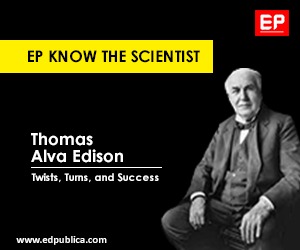
In addition to the electric bulb, Edison patented more than a thousand inventions such as the motion picture camera, the phonograph, the electrical vote recorder, the alkaline storage battery, and sound recording. He also started a research laboratory for the first time in the world on an industrial basis. With the invention of the light bulb and direct current, he made electricity an irreplaceable thing in the world.
It may seem difficult to believe that a child who was once dismissed from school as an unintelligent student, with a hearing impairment, later became a great inventor known throughout the world. But yes, life had many twists and turns for that boy named Thomas Alva Edison.
An unintelligent student
Thomas Edison was born on February 11, 1847, in Milan, Ohio, the US. He was from an ordinary family who immigrated to America from Canada. Edison’s father, Samuel Edison, owned a wood business in Milan. Thomas Edison was the seventh son of his mother Nancy Edison and Samuel. When he was eight, the family had to move to Port Huron. It was during this time that Edison was admitted to school. But a teacher once described Edison as a ‘stupid student’ who was not good at studies.
In addition to the electric bulb, Edison patented more than a thousand inventions such as the motion picture camera, the phonograph, the electrical vote recorder, the alkaline storage battery, and sound recording. He also started a research laboratory for the first time in the world on an industrial basis. With the invention of the light bulb and direct current, he made electricity an irreplaceable thing in the world.
One day, a letter was sent to Edison from school to give to his mother. Seeing tears in her eyes, Edison asked about the letter. “Your son has a lot of talent for his age.” As it turns out, there won’t be enough facilities or teachers at this school to guide him. “It is therefore better that you teach him yourself.” Edison’s mother told him after she had read it.
From then on, Edison’s teacher was his mother. Just three months of schooling ended with that.
Edison was raised under the tutelage of his mother, who did not even receive a primary school education. Realizing her son’s strengths and weaknesses, the mother nurtured him accordingly. It was his mother who made Edison a world-renowned great and encouraged his talents.
Edison himself once said about it like this, ‘My mother made me who I am. It was my mother who made me feel that I had a purpose in life and that I had someone with me so that I wouldn’t be disappointed.’
The power of confidence
Edison’s parents were not in a good financial position. But still, they bought many books for him. Reading the science books among them, he was inspired to do his own experiments. But all the early experiments were failures.

But Edison was not ready to give up his confidence and efforts. He grew up and became a world-renowned scientist as a result of great effort and hard work. The genius worked on himself by tasting failure rather than success.
Later, Edison found a piece of paper while sorting through old things in his house. Edison took it and realized that it was a letter from the school that he had given to his mother in the past. Edison cried when he read it. ‘Your son is a foolish child. We don’t want to waste time teaching him. So please do not send him to school from now on…’ were the lines of the letter.
Edison said that if his mother had read the letter like this or scolded him, he would have become an incompetent child with no confidence. If his mother had not recognized Edison’s talent and encouraged it, the world would have lost it.
>> Edison held 389 patents related to electric light and the field alone
Edison began walking toward his dreams in 1859 at the age of 12 as a newspaper salesman on trains between Port Huron and Detroit. It was during this time that Edison lost his right ear due to an illness. But later with the industrialization of the telegraph, he became an apprentice telegrapher in 1863 due to his interest in learning about it. This was a turning point in Edison’s life. The period when Edison realized that he could do many things. The experiments continued.
Having done many jobs again, he had also realized his inner businessman by this time. Edison received his first patent in 1869. He found that the right to consent could be exercised effortlessly in an electric vote recorder. In the same year, he also invented the duplex telegraph, which could send two messages at the same time.
Being a telegraph operator helped Edison shine in the field of telegraphy. Beating the best telegraph company of the time, the Western Union Telegraph Company, Edison invented the quadruplex telegraph, which could send four messages simultaneously over a single wire.
Later, the Western Union company paid Edison one hundred thousand dollars to acquire the rights. This was his first big reward. It was the highest amount anyone could receive for any discovery up to that time.
Then Edison invented the automatic telegraph, which recorded messages automatically through electrical transmission, but it was not a great industrial success. But he followed up this chemical discovery with the invention of the electric pen, the mimeograph, and the phonograph.
Edison invented the electric light bulb in October 1879. In 1982, New York’s Pearl Street began supplying electricity. So it was Edison who made the world think that light means a bulb. Edison also invented the kinetograph, a moving camera that could take moving pictures.
He is the one who first paved the way for filming the movies and videos that we enjoy today. Many technologies, including sound recording on film, were the result of Edison’s efforts. Many of the things we use in our daily lives today were the first form of his contribution. All of these were revolutionary discoveries that changed the course of time.
Wizard of Menlo Park
One of the most important stages in Edison’s life began in the laboratory he started in Menlo Park, New Jersey. In 1876 Edison started the first industrial research laboratory in the world. Edison, an entrepreneur and industrialist, grew up from there.
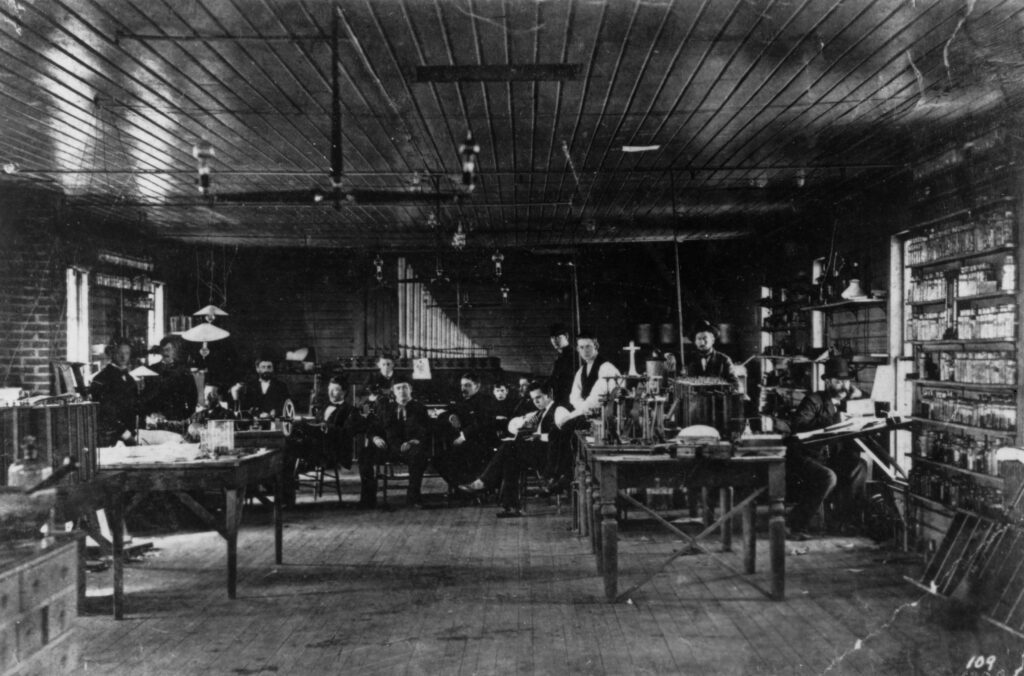
Many discoveries known to the world were born from here. Edison had many assistants here. As a result of their efforts, there was a torrent of patents under Edison’s name at that time.
He has received 1093 patents in the United States alone and has also received other patents from the UK, Germany, and France. Edison held 389 patents related to electric light and the field alone.
With his intelligence, self-confidence, and hard work, Edison jumped to the forefront despite all the crises and practical difficulties. But in the meantime, some disputes that arose with the inventor Nikola Tesla led to many controversies at that time in the name of the ‘current war’.

Know The Scientist
Remembering S.N. Bose, the underrated maestro in quantum physics
Rejected in Britain, celebrated by Einstein, here’s the story of S.N. Bose, the Indian physicist who formulated quantum statistics, now a bedrock theory in condensed matter physics.
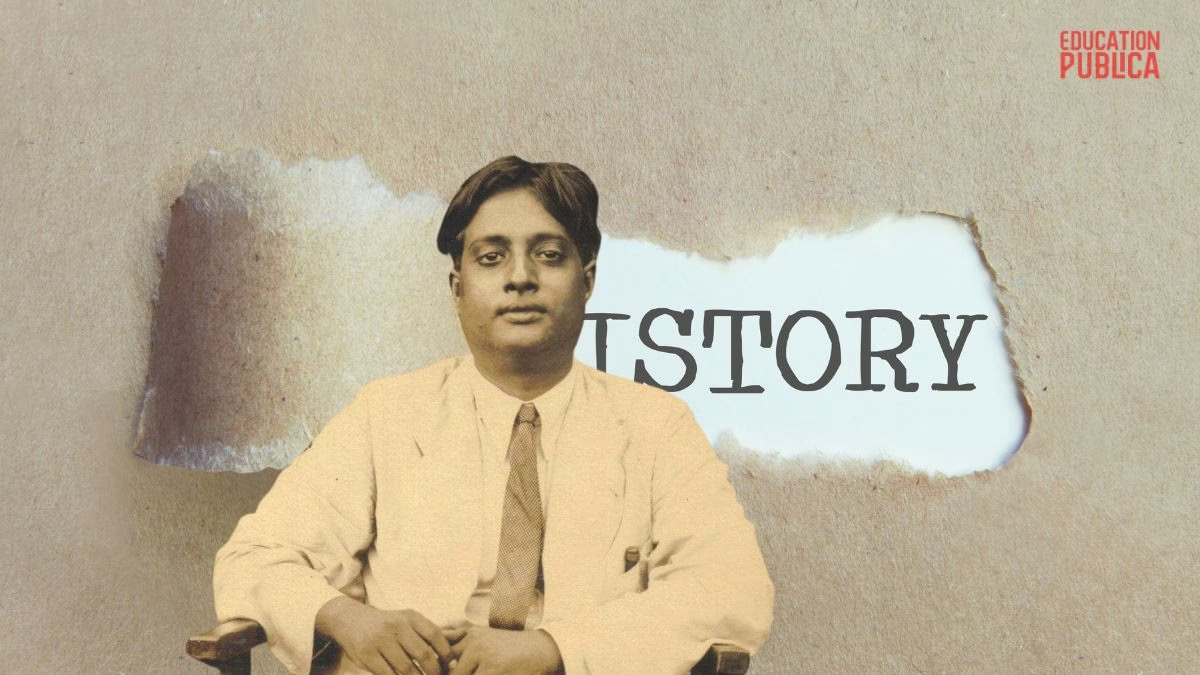
It’s 1924, and Satyendra Nath Bose, going by S.N. Bose was a young physicist teaching in Dhaka, then British India. Grappled by an epiphany, he was desperate to have his solution, fixing a logical inconsistency in Planck’s radiation law, get published. He had his eyes on the British Philosophical Magazine, since word could spread to the leading physicists of the time, most if not all in Europe. But the paper was rejected without any explanations offered.
But he wasn’t going to give up just yet. Unrelenting, he sent another sealed envelope with his draft and this time a cover letter again, to Europe. One can imagine months later, Bose breathing out a sigh of relief when he finally got a positive response – from none other than the great man of physics himself – Albert Einstein.
In some ways, Bose and Einstein were similar. Both had no PhDs when they wrote their treatises that brought them into limelight. And Einstein introduced E=mc2 derived from special relativity with little fanfare, so did Bose who didn’t secure a publisher with his groundbreaking work that invented quantum statistics. He produced a novel derivation of the Planck radiation law, from the first principles of quantum theory.
This was a well-known problem that had plagued physicists since Max Planck, the father of quantum physics himself. Einstein himself had struggled time and again, to only have never resolved the problem. But Bose did, and too nonchalantly with a simple derivation from first principles grounded in quantum theory. For those who know some quantum theory, I’m referring to Bose’s profound recognition that the Maxwell-Boltzmann distribution that holds true for ideal gasses, fails for quantum particles. A technical treatment of the problem would reveal that photons, that are particles of light with the same energy and polarization, are indistinguishable from each other, as a result of the Pauli exclusion principle and Heisenberg’s uncertainty principle.
Fascinated and moved by what he read, Einstein was magnanimous enough to have Bose’s paper translated in German and published in the journal, Zeitschrift für Physik in Germany the same year. It would be the beginning of a brief, but productive professional collaboration between the two theoretical physicists, that would just open the doors to the quantum world much wider. Fascinatingly, last July marked the 100 years since Einstein submitted Bose’s paper, “Planck’s law and the quantum hypothesis” on his behalf to Zeitschrift fur Physik.
With the benefit of hindsight, Bose’s work was really nothing short of revolutionary for its time. However, a Nobel Committee member, the Swedish Oskar Klein – and theoretical physicist of repute – deemed it a mere advance in applied sciences, rather than a major conceptual advance. With hindsight again, it’s a known fact that Nobel Prizes are handed in for quantum jumps in technical advancements more than ever before. In fact, the 2001 Nobel Prize in Physics went to Carl Wieman, Eric Allin Cornell, and Wolfgang Ketterle for synthesizing the Bose-Einstein condensate, a prediction made actually by Einstein based on Bose’s new statistics. These condensates are created when atoms are cooled to near absolute zero temperature, thus attaining the quantum ground state. Atoms at this state possess some residual energy, or zero-point energy, marking a macroscopic phase transition much like a fourth state of matter in its own right.
Such were the changing times that Bose’s work received much attention gradually. To Bose himself, he was fine without a Nobel, saying, “I have got all the recognition I deserve”. A modest character and gentleman, he resonates a lot with the mental image of a scientist who’s a servant to the scientific discipline itself.
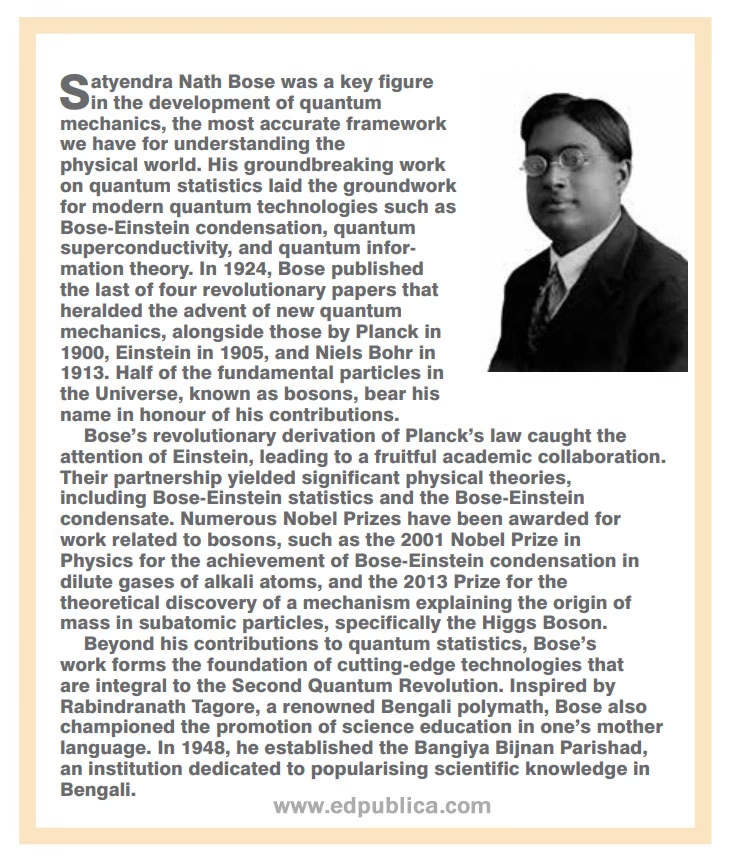
But what’s more upsetting is that, Bose is still a bit of a stranger in India, where he was born and lived. He studied physics at the Presidency College, Calcutta under the tutelage that saw other great Indian physicists, including Jagdish Chandra Bose and Meghnad Saha. He was awarded the Padma Vibhushan, the highest civilian award by the Government of India in 1954. Institutes have been named in his honour, but despite this, his reputation has little if no mention at all in public discourse.
To his physicists’ peers in his generation and beyond, he was recognized in scientific lexicology. Paul Dirac, the British physicist coined the name ‘bosons’ in Bose’s honor (‘bose-on’). These refer to quantum particles including photons and others with integer quantum spins, a formulation that arose only because of Bose’s invention of quantum statistics. In fact, the media popular, ‘god particle’, the Higgs boson, carries a bit of Bose as much as it does of Peter Higgs who shared the 2013 Nobel Prize in Physics with Francois Euglert for producing the hypothesis.
Know The Scientist
Narlikar – the rare Indian scientist who penned short stories
Jayant Narlikar has been one of the most prolific scientists, and science communicators India has ever produced. The octogenarian had died at his residence in Pune.

Jayant Narlikar passed away at his Pune residence on Tuesday. He was 86-years old, and had been diagnosed with cancer. With his demise, India lost a prolific scientist, writer, and institution builder.
In 2004, the government of India had honored Narlikar with the Padma Vibhushan, the second-highest civilian award, for his services to science and society. But that was not his first recognition from the Indian government. At the age of 26, he had received his first Padma Bhushan, in recognition for his work in cosmology, studying the universe’s large-scale structures. He helped contribute to derive Einstein’s field equations of gravity from a more general theory. That work, dubbed the Narlikar-Hoyle theory of gravity, was borne out a collaboration with Narlikar’s doctoral degree supervisor at Cambridge; Fred Hoyle, the then leading astrophysicist of his time.
Narlikar and the steady-state theory
Narlikar and Hoyle bonded over a shared skepticism towards the prevalent Big Bang hypothesis, which sought to extrapolate the universe’s ongoing expansion to its birth at some finite time in the past. However, Narlikar and Hoyle could not have been more opposed, mostly out of their own philosophical beliefs. They drew upon the works of 19th century Austrian physicist and philosopher, Ernest Mach, in rejecting a theory discussing the universe’s beginning in the absence of a reference frame. As such, Narlikar was a strong proponent of Hoyle’s steady-state model of the universe, in which the universe is infinite in extent, and indefinitely old. As such, the steady-state theorists explained away the universe’s expansion to matter being spawned into existence from this vacuum at every instant, aka a C-field.
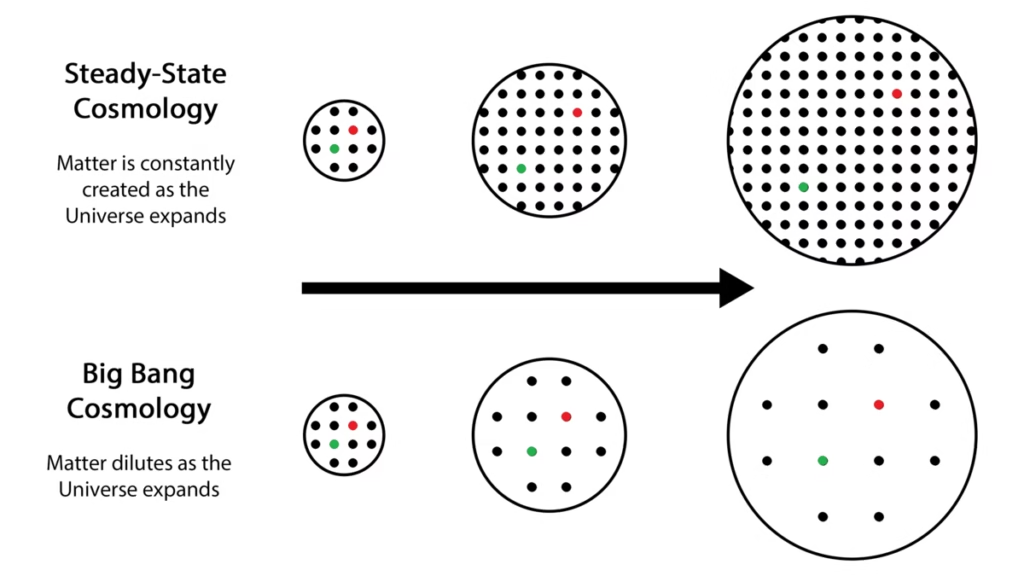
However, the steady-state’s predictions did not hold up in face of evidence the universe expands over time. Nor did its successive avatar, the quasi-steady state theory devised sway scientific consensus. The death knell came when evidence of the cosmic microwave background (aka the CMB) was discovered in 1964.
Despite steady-state’s failure, it provided healthy rivalry to the Big Bang from the 1940s to the 60s, providing opportunities for astronomers to compare observations to precise predictions. In the words of the Nobel laureate Steven Weinberg, “In a sense, this disagreement is a credit to the model; alone among all cosmologies, the steady state model makes such definite predictions that it can be disproved even with the limited observational evidence at our disposal.”
The Kalinga winning short-story writer
Narlikar was more than just a cosmologist, studying the large-scale structure of the universe. He also had been an acclaimed science fiction writer, with his works penned in English, Hindi, and in his vernacular, Marathi. His famous work was a short-story, Dhoomekethu (The Comet), revolving around themes of superstition, faith, rational and scientific thinking. Published in Marathi in 1976, with translations available in Hindi, the story was adapted later into a two-hour film bearing the same name. In 1985, the film aired on the state-owned television broadcasting channels, Doordarshan.
In a way, he was India’s Carl Sagan, airing episodes explaining astronomical concepts, with children being his target audience. The seventeen-episode show, Brahmand (The Universe), aired in 1994, to popular acclaim. One of his most popular books, Akashashi Jadle Nathe (Sky-Rooted Relationship), remains popular. An e-book version in Hindi is available on Goodreads, with 470 reviewers lending an average rating of 4.7 out of 5.
His efforts was honored with an international prize. In 1996, he received the much-coveted Kalinga Prize for the Popularization of Science, awarded annually in India by the United Nations Educational, Scientific and Cultural Organization (UNESCO), “in recognition of his efforts to popularize science through print and electronic media.” Narlikar had been only the second Indian at the time, after the popular science writer Jagjit Singh, to have received the award.
When Narlikar returned to India, accepting a position at the Tata Institute of Fundamental Research (TIFR), he realized that the fruits of astrophysical research did not flourish outside central institutions. Though Bengaluru had an Indian Institute of Astrophysics, Narlikar envisioned basing a research culture paralleling his time at Cambridge. Hence, the Inter-University Centre for Astronomy and Astrophysics (IUCAA) was born in 1988, and Narlikar was appointed its founding director. Arguably, his most visible legacy would have been to shape India’s astrophysical research culture through his work with the IUCAA (pronounced “eye-you-ka”).
Know The Scientist
Dr. Nikku Madhusudhan Brings Us Closer to Finding Life Beyond Earth
Dr. Madhusudhan, a leading Indian-British astrophysicist at the University of Cambridge, has long been on the frontlines of the search for extraterrestrial life

Somewhere in the vast, cold dark of the cosmos, a planet orbits a distant star. It’s not a place you’d expect to find life—but if Dr. Nikku Madhusudhan is right, that assumption may soon be history.
Dr. Madhusudhan, a leading Indian-British astrophysicist at the University of Cambridge, has long been on the frontlines of the search for extraterrestrial life or what we call the alien life. This month, his team made headlines around the world after revealing what could be the strongest evidence yet of life beyond Earth—on a distant exoplanet known as K2-18b.
Using data from NASA’s James Webb Space Telescope, Madhusudhan and his collaborators detected atmospheric signatures of molecules commonly associated with biological processes on Earth—specifically, gases produced by marine phytoplankton and certain bacteria. Their analysis suggests a staggering 99.7% probability that these molecules could be linked to living organisms.
“This marked the first detection of carbon-bearing molecules in the atmosphere of an exoplanet located within the habitable zone,” the University of Cambridge said in a press statement. “The findings align with theoretical models of a ‘Hycean’ planet — a potentially habitable, ocean-covered world enveloped by a hydrogen-rich atmosphere.”
Born in India, Dr. Madhusudhan began his journey in science with an engineering degree from IIT (BHU) Varanasi
In addition, a fainter signal suggested there could be other unexplained processes occurring on K2-18b. “We didn’t know for sure whether the signal we saw last time was due to DMS, but just the hint of it was exciting enough for us to have another look with JWST using a different instrument,” said Professor Nikku Madhusudhan in a news report released by the University of Cambridge.
The man behind the mission
Born in India, Dr. Madhusudhan began his journey in science with an engineering degree from IIT (BHU) Varanasi. But it was during his time at the Massachusetts Institute of Technology (MIT), under the mentorship of exoplanet pioneer Prof. Sara Seager, that he found his calling. His doctoral work—developing methods to retrieve data from exoplanet atmospheres—would go on to form the backbone of much of today’s planetary climate modeling.
Now a professor at the University of Cambridge’s Institute of Astronomy, Madhusudhan leads research that straddles the line between science fiction and frontier science.
A Universe of Firsts
Over the years, his work has broken new ground in our understanding of alien worlds. He was among the first to suggest the concept of “Hycean planets”—oceans of liquid water beneath hydrogen-rich atmospheres, conditions which may be ideal for life. He also led the detection of titanium oxide in the atmosphere of WASP-19b and pioneered studies of K2-18b, the same exoplanet now back in the spotlight.
His team’s recent findings on K2-18b may be the closest humanity has ever come to detecting life elsewhere in the universe.
Accolades and impact
Madhusudhan’s contributions have earned him global recognition. He received the prestigious IUPAP Young Scientist Medal in 2016 and the MERAC Prize in Theoretical Astrophysics in 2019. In 2014, the Astronomical Society of India awarded him the Vainu Bappu Gold Medal for outstanding contributions to astrophysics by a scientist under 35.
But for Madhusudhan, the real reward lies in the questions that remain unanswered.
Looking ahead
Madhusudhan cautions that, while the findings are promising, more data is needed before drawing conclusions about the presence of life on another planet. He remains cautiously optimistic but notes that the observations on K2-18b could also be explained by previously unknown chemical processes. Together with his colleagues, he plans to pursue further theoretical and experimental studies to investigate whether compounds like DMS and DMDS could be produced through non-biological means at the levels currently detected.
Beyond the lab, Madhusudhan remains dedicated to mentoring students and advancing scientific outreach. He’s a firm believer that the next big discovery might come from a student inspired by the stars, just as he once was.
As scientists prepare for the next wave of data and the world watches closely, one thing is clear: thanks to minds like Dr. Nikku Madhusudhan’s, the search for life beyond Earth is no longer a distant dream—it’s a scientific reality within reach.
-

 Society4 months ago
Society4 months agoStarliner crew challenge rhetoric, says they were never “stranded”
-

 Space & Physics3 months ago
Space & Physics3 months agoCould dark energy be a trick played by time?
-

 Earth4 months ago
Earth4 months agoHow IIT Kanpur is Paving the Way for a Solar-Powered Future in India’s Energy Transition
-

 Space & Physics3 months ago
Space & Physics3 months agoSunita Williams aged less in space due to time dilation
-

 Learning & Teaching4 months ago
Learning & Teaching4 months agoCanine Cognitive Abilities: Memory, Intelligence, and Human Interaction
-

 Earth2 months ago
Earth2 months ago122 Forests, 3.2 Million Trees: How One Man Built the World’s Largest Miyawaki Forest
-

 Women In Science3 months ago
Women In Science3 months agoNeena Gupta: Shaping the Future of Algebraic Geometry
-

 Society5 months ago
Society5 months agoSustainable Farming: The Microgreens Model from Kerala, South India

















